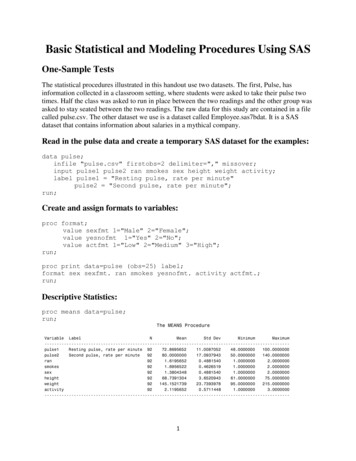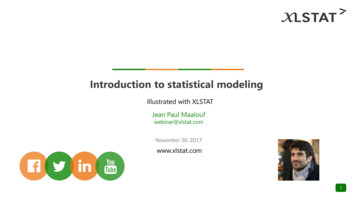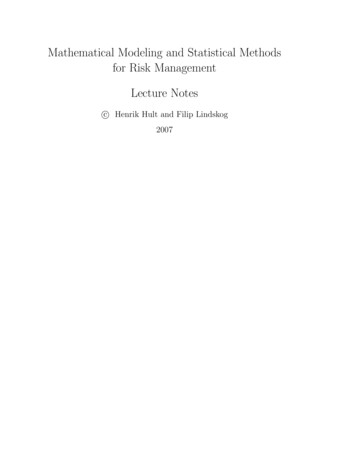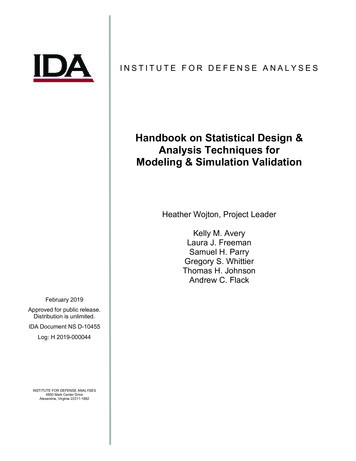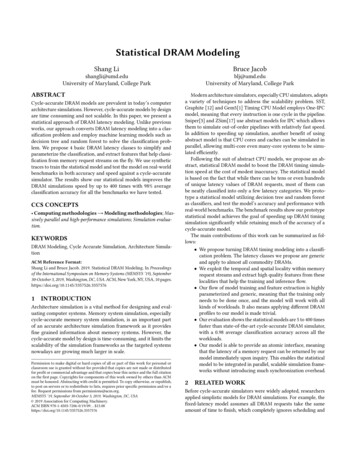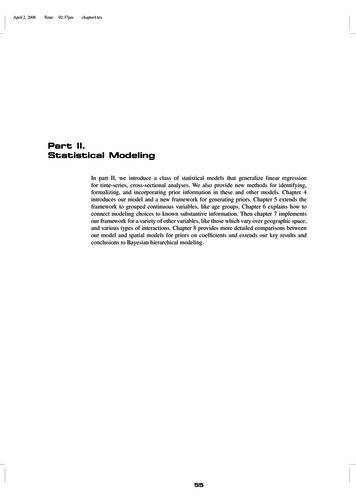
Transcription
April 2, 2008Time:02:37pmchapter4.texPart II.Statistical ModelingIn part II, we introduce a class of statistical models that generalize linear regressionfor time-series, cross-sectional analyses. We also provide new methods for identifying,formalizing, and incorporating prior information in these and other models. Chapter 4introduces our model and a new framework for generating priors. Chapter 5 extends theframework to grouped continuous variables, like age groups. Chapter 6 explains how toconnect modeling choices to known substantive information. Then chapter 7 implementsour framework for a variety of other variables, like those which vary over geographic space,and various types of interactions. Chapter 8 provides more detailed comparisons betweenour model and spatial models for priors on coefficients and extends our key results andconclusions to Bayesian hierarchical modeling.55
April 2, 2008Time:02:37pmchapter4.tex56
April 2, 2008Time:02:37pm4chapter4.texThe ModelY4.1 OverviewThe specific models introduced in this chapter all depend on the specification of priors,which we introduce here and then detail in the rest of part II. Details of how one cancompute estimates using this model appear in part III. Our strategy is to begin with themodels in chapter 3 that use covariates and add in information about the mortality ageprofile in a different way than in the models in chapter 2. After putting all the informationfrom both approaches in a single model, we then add other information not in either, suchas the similarity of results from neighboring countries or time periods.In this section, we use a general Bayesian hierarchical modeling approach to information pooling.1 Although developing models within the Bayesian theory of inference isentirely natural from the perspective of many fields, in several respects it is a departurefor demography. It contrasts most strikingly with the string of scholarship extending overmost of the past two centuries that seeks to find a low-dimensional parametric form for themortality age profile (see section 2.4 and the remarkable list in Tabeau 2001). It has morein common with principle components approaches like Lee-Carter, in that we also do notattempt to parameterize the age profile with a fixed functional form, but our approach ismore flexible and capable of including covariates as well as modeling patterns known fromprior research in demography or any other patterns chosen by the researcher. Our approachalso contrasts with the tendency of demographers to use their detailed knowledge only asan ex post check on their results. We instead try to incorporate as much of this informationas possible into the model. Our methods tend to work better only when we incorporateinformation demographers have about observed data or future patterns.The opposite, of course, applies too. Researchers forecasting variables for which noprior quantitative or qualitative analyses or knowledge exists will not benefit from the useof our methods. And those who use incorrect information may degrade their forecasts byadding priors.Although our approach can work in principle with any relevant probability density forlog-mortality, including those based on event count models discussed in section 3.1.1, wefix ideas by developing our model by building on the equation-by-equation least-squares1 Forother approaches to Bayesian hierarchical modeling, and for related ideas, see Blattberg and George (1991),Gelman et al. (2003), Gelman and Hill (2007), Gill (2002), and Western (1998).
April 2, 2008Time:5802:37pm chapter4.texCHAPTER 4model, described in section 3.1.2. This model is σi2m it N µit ,biti 1, . . . , N , t 1, . . . T(4.1)µit Zit β i ,where, as before, m it is the log-mortality rate (or a generic dependent variable) with meanµit and variance σi2 /bit , bit is some exogenous weight, and Zit is a vector of exogenouscovariates. We are not concerned with the choices of the weights bit and the covariates Zithere (we discuss these specification decisions in chapter 6). Although they are crucial, theirspecifics have no effect on the overall structure of our model.Specification 4.1 forms the basic building block of our hierarchical Bayesian approach,and so we now interpret the coefficients β i and the standard deviations σi as randomvariables, with their own prior distributions. We denote the prior for the variables σigenerically as P(σ ). The prior for the coefficients β, which usually depends on one ormore hyperparameters θ , we denote by P(β θ ). The hyperparameters θ also have a priordistribution P(θ ). (By our notation conventions, P(θ ) and P(σ ) are different mathematicalexpressions; see appendix A.)We choose the specific functional form of the priors P(σ ) and P(θ ) to make thecomputations simple (usually a Gamma or inverse-Gamma density), with the mean andvariance set to be diffuse so they do not have an important effect on our results. Incontrast, our central arguments in this chapter, and most of the rest of this book, areabout the specification for the prior for the coefficients, P(β θ ). This prior will be taken ashighly informative, reflecting considerable prior knowledge. The issue at hand is decidingprecisely how to formalize this prior knowledge in this density.Using the likelihood function P(m β, σ ) from equation 3.8 (page 45), and assumingthat σ is a priori independent of β and θ , we express the posterior distribution of β, σ and θconditional on the data m asP(β, σ, θ m) P(m β, σ ) [P(β θ )P(θ )P(σ )] ,(4.2)where P(β, θ, σ ) P(β θ )P(θ )P(σ ) is the prior. Once the prior densities have beenspecified, we usually summarize the posterior density of β with its mean, β Bayes βP(β, σ, θ m) dβdθ dσ,(4.3)(or the mode) and can then easily compute forecasts using one of the three methodsdescribed in section 3.1.3.This section provides a framework for the information pooling problem. By choosinga suitable prior density for β, we summarize and formalize prior qualitative knowledgeabout how the coefficients β are related to each other, so that information is shared amongcross sections. If the prior for β is specified appropriately, the information content of ourestimates of β will increase considerably. This, in turn, can result in more informative andmore accurate forecasts.
April 2, 2008Time:02:37pmchapter4.texTHE MODEL 594.2 Priors on CoefficientsAs we have described, a common way to derive a prior for β is to use the following kindof prior knowledge: “similar” cross sections should have “similar” coefficients. The mostcommon approach is to use a class of Markov random field priors, which are an exampleof an intrinsic autoregressive prior. These models are closely related to the autoregressivepriors pioneered by Besag and his colleagues (Besag, 1974, 1975; Besag and Kooperberg,1995; Iversen, 2001) in that they allow spatial smoothing for units like age groups thatvary over nongeographical space. The priors formalize this knowledge by introducing thefollowing density: 1(4.4)P(β ) exp H β [β, ] ,2whereH β [β, ] 1 si j β i β j 2 ,2 ij(4.5)where we use the notation x 2 to refer to the weighted Euclidean norm x x and wherethe symmetric matrix s is known as the adjacency matrix, and its elements can be thoughtof as the inverse of the “distance,” or the proximity, between cross section i and crosssection j.2 It is useful, for future reference, to write equation 4.5 in an alternative way:H β [β, ] Wi j β i β j ,(4.6)ijwhere W s s is a positive semidefinite symmetric matrix whose rows sum to 1(see appendix B.2.6, page 237). The matrix is a generic symmetric, positive definitematrix of parameters, which help summarize the distance between vectors of coefficients.Because it is usually unknown, the matrix is considered to be a set of hyperparameters tobe estimated, with its own prior distribution. In practice this matrix is likely to be takento be diagonal in order to limit the number of the unknowns in the model, although thisspecification implies the strong assumption that elements of the coefficient differences(β i β j ) are a priori independent of each other. It also implies that is constant overi, which we show later is highly improbable in many applications.The function H β [β, ] assumes large values when similar cross sections (e.g.,si j “large”) have coefficients far apart (i.e., β i β j is also “large”). Therefore,equation 4.4 simply says that, a priori, the most likely configurations of coefficients βare those in which similar cross sections have similar coefficients or, in other words, thosein which the coefficients β vary smoothly across the cross sections.A key point is that the prior defined by equations 4.4 and 4.5 is improper (whichmeans that the probability density in equation 4.4 integrates to infinity; see appendix C).2 Althoughconstraining the elements of this matrix to be positive is consistent with their interpretation asproximities, the constraint is not necessary mathematically. The only constraint on s is that the quadratic formdefined by equation 4.5 be positive definite.
April 2, 2008Time:6002:37pm chapter4.texCHAPTER 4The improperness stems from the fact that the function H β [β, ] is constant and equal to 0whenever β i and β j are equal, regardless of the levels at which the equality occurs (i.e.,in the subspace β i β j , i, j 1, . . . , N ). This causes no statistical difficulties: becausethe likelihood is proper (and normal), the posterior is always proper. Indeed, an improperprior is a highly desirable feature in most applications, because it constrains the regressioncoefficients not to be close to any particular value (which would normally be too hard tospecify from prior knowledge) but only to be similar to each other. In other words, the priordensity in equation 4.4 is sensitive not to the absolute values or levels of the coefficients,only to their relative values.Example 1 Suppose the cross sections are labeled only by countries (with no age groupsubclassification). Then s could be a symmetric matrix of zeros and ones, where si j 1indicates that country i and country j are “neighbors,” in the sense that we believe theyshould have similar regression coefficients. Neighbors could also be coded on the basis ofphysical contiguity, proximity of major population areas, or frequency of travel or tradebetween the countries. In practice, the matrix s would need to be constructed by hand by agroup of experts on the basis of their expectations of which countries should have similarcoefficients, which, of course, requires the experts to understand the meaning of all theregression coefficients and how they are supposed to vary across countries. Example 2 Suppose cross sections are labeled by age groups, or by a similar variable witha natural ordering (with no country-level subclassification). Then s could be a tridiagonalmatrix of ones, so that every age group has as neighbors its two adjacent age groups.A more general choice is a band matrix, with the size of elements decaying as a functionof the distance from the diagonal. Although the general pattern desired may be clear fromprior knowledge, choosing the particular values of the elements of s in this situation wouldbe difficult, because they do not directly relate to known facts or observed quantities. 4.3 Problems with Priors on CoefficientsFor any Bayesian approach to model 4.1, we will ultimately need a prior for β. The issueis how to turn qualitative and impressionistic knowledge into a specific mathematical form.But herein lies a well-known disconnect in Bayesian theory: because the prior knowledgewe have is typically in a very different form than the probability density we ultimately need,the task of choosing a density often requires as much artistic choice as scientific analysis.In many Bayesian models, this disconnect is spanned with a density that forms a reasonableapproximation to prior knowledge.Unfortunately, in some applications of Bayesian models with covariates, the disconnectcan be massive and the resulting density chosen is often inappropriate. Our critique appliesto many Bayesian spatial or hierarchical models that put a prior on a vector of coefficientsand where the prior is intended to convey information. The problem here is that the jumpfrom qualitative knowledge to prior density is too large, and some steps are skipped orintuited incorrectly. This argument applies to many models with spatial smoothing, likethat in equation 4.4, and more generally to hierarchical models with clusters of units thatinclude covariates. We describe these problems here with spatial smoothing and make theextension to hierarchical models, featuring clusters of exchangeable units, in section 8.2.
April 2, 2008Time:02:37pmchapter4.texTHE MODEL 614.3.1 Little Direct Prior Knowledge Exists about CoefficientsTo put a prior on the vector β, we need to be in possession of nonsample knowledge aboutit. When an element of β coincides with a specific causal effect, the claim to nonsampleknowledge is complicated, but sometimes plausible. For example, we know that 25 yearsof tobacco consumption causes a large increase in the probability of death (from lungcancer, heart disease, and other causes) in humans. However, the β in our models are at thepopulation level, and so they are not necessarily causal effects. For example, if we observethat tobacco consumption is positively related to lung cancer mortality across countries,it may be that smokers are getting lung cancer, but it could also be true—on the basisof the same patterns in the aggregate data—that it is the nonsmokers who happen to livein countries with high tobacco consumption who are dying at increasing rates. Whetherwe can imagine the reason for such a pattern is unimportant. It can occur, and if it does,the connection from the aggregate level relationship to the individual level at which thebiological causal effect is known may be severed. This, of course, is an example of thewell-known ecological inference problem (Goodman, 1953; King, 1997), the point beingthat without special models to deal with the problem, β may not contain causal effects evenfor a covariate as apparently obvious as tobacco consumption.A better case for the claim of prior knowledge about β may be variables where thecausal effect operates at the country level. For example, a democratic electoral system ora comprehensive health care system may lead to lower mortality from a variety of causes.Although these effects would also operate at the individual level, the causal effect couldplausibly occur at the societal level. In that situation, no ecological inference problemexists, and the case that we may really possess prior knowledge about at least this coefficientis more plausible.Even, however, when one coefficient is truly causal, its interpretation is clear, and muchprior knowledge exists about its likely direction and magnitude, it is typically not the onlycoefficient. Normally, we have a set of control variables with corresponding coefficients.The problem is that coefficients on control variables are treated as nuisance parameters, aretypically not the subject of study, and are rarely of any direct interest. As such, even forregressions that include well-specified causal effects, we will often have little direct priorknowledge about most of the coefficients.In some areas, of course, whole literatures have built up around repeated analysesof similar specifications that lead to much knowledge about coefficients. For example, inepidemiological studies, age and sex are often the only important confounders and aretypically used to stratify the data sets prior to analyses. Many of the statistical specificationsthen include a treatment variable only weakly correlated with the pretreatment controlvariables included in the analysis, each of which has only a small effect on the outcome.As Greenland (2001, p. 667–668) points out, sufficient knowledge does exist to put priorson the coefficients in situations like these. Indeed, many of these studies are based oncase-control designs where estimating base probabilities was not done and long thoughtimpossible (although it has now been shown to be straightforward; see King and Zeng2002), and so in these areas putting priors on the expected outcome is more difficult andperhaps less natural.A final point is that β is not scale invariant with respect to Z: if we double Z, we arealso halving β. This is not a problem if we truly understand the coefficients, because wewould merely scale everything appropriately and set the prior to suit. When the coefficients’
April 2, 2008Time:6202:37pm chapter4.texCHAPTER 4values are not fully understood, however, several problems can ensue. The main problemhere is that the whole model requires that β take on the same meaning for all cross-sectionalunits. If the meaning or scale of Z changes at all, however, then the prior should change.Yet, the parameters in equation 4.4 have no subscript and are assumed constant overall units. In some situations, this is plausible but, even for variables like GDP, we expectsome changes in scale over the units, even after attempts to convert currencies and costsof living.This problem is sometimes addressed by standardizing Z in some way, such asby subtracting its sample mean and dividing by its sample standard deviation. Thisundoubtedly helps in some situations, but it just as certainly does not solve the problem. Fora simple example, suppose one covariate is GDP per capita and another is real disposableincome per 100 population. Suppose that the right normalization here is to multiply GDPby 100 (even though this assumes away a host of other potential problems). Now supposethat, for whatever reason, GDP per capita varies very little over countries in some dataset, but real disposable income varies enormously. In that situation, standardization wouldexacerbate the problem rather than solve it. The general problem here is that the sampledoes not necessarily contain sufficient information with which to normalize the covariates.Some exogenous information is typically needed.4.3.2 Normalization Factors Cannot Be EstimatedWhether the coefficients are meaningful or not, the prior in equation 4.4 contains theexpression β i β j , which implies that the coefficients can all be made comparable. Inparticular, it assumes that we can translate the coefficient on one variable in a single crosssectional regression to the scale of a coefficient on another variable in that cross sectionor some other cross section. Indeed, this prior specifies a particular metric for translation,governed by the hyperprior parameter matrix .To be more specific, we denote individual explanatory variables by the index v, andrewrite equation 4.5 (page 59) asH β [β, ] 1 si j β i β j 2 2 ij Wi j β iv bvj ,(4.7)i jvwhere W is a function of s defined in appendix B.2.6 (page 237), and, most importantly, bvj vv β vj(4.8)v is the translation of coefficient v in cross section j, into the same scale as that for coefficientv in cross section i.As is more obvious in this formulation, serves the critical role of normalizationconstants, making it possible to translate from one scale to another. For example, ifwe multiply degrees Celsius by 9/5 and add 32, we get degrees Fahrenheit, where thenumbers 9/5 and 32 are the normalization constants. The translations that must beable to perform include normalizing to the same scale (1) coefficients from different
April 2, 2008Time:02:37pmchapter4.texTHE MODEL 63covariates in the same cross-sectional regression, (2) coefficients from the same covariatein different cross-sectional regressions, and (3) coefficients from different covariates indifferent cross-sectional regressions. Each of these three cases must be made equivalent vianormalization, and all this prior knowledge about normalization must be known ex ante andcoded in .The role of the normalization can be seen even more clearly by simplifying theproblem to one where is diagonal. In this situation, the normalization factor is especiallysimple: bvj vv β vj ,and so vv simply provides the weights to multiply into the coefficient vector in one crosssection to get the coefficient vector in another cross section.This alternative formulation is appropriate only if we have prior knowledge thatdifferent components of β are independent. In other words, although equation 4.8 containsthe correct normalization, regardless of independence assumptions, the prior in equation 4.7allows us to use only those parts of the normalization that are relevant to formingthe posterior, and independence among components of β means that the cross-productterms (i.e., when v v ) in equation 4.8 would not be needed. Although assuming thatelements of a prior are independent is common in Bayesian modeling, the assumptionof independence is far from innocuous here, because the result can greatly affect thecomparability of coefficients from different cross sections or variables and thus canenormously influence the final result.The key to putting priors on coefficients is knowing . Without this knowledge, thetranslation from one scale to another will be wrong, the prior will not accurately conveyknowledge, and our estimates and forecasts would suffer. Unfortunately, because we oftenknow little about many of the β coefficients, researchers usually know even less aboutthe values in . Any attempt within the Bayesian theory of inference to bring the data tobear on the prior parameter values will fail, which is easy to see by trying to estimate bymaximizing the posterior: because does not appear in the likelihood, the entire likelihoodbecomes an arbitrary constant and can be dropped. As such, under Bayes, the data play norole in helping us learn about ; all information about it must come from prior knowledge,which, of course, is the problem.Some scholars try to respond to the lack of knowledge of as good Bayesians byadding an extra layer to the modeling hierarchy and putting a proper hyperprior on .Ultimately, however, we always need to choose a mean for the distribution of . Andthat deeply substantive choice will be critical. Adding variance around the mean does nothelp much in this situation because it merely records the degree to which the smoothingprior on β (and our knowledge of the normalization factor) is irrelevant in forming themodel posterior: if a prior on the coefficients is to do any good, one must know thenormalization factor, , or choose a sufficiently narrow variance for the prior on it.Otherwise, no Bayesian shrinkage occurs, and the original motivation for using the modelvanishes.The fact is that is inestimable from the given data and must be imposed a prioriwith exogenous knowledge. Adding a prior so that is identified does not help unlessthat prior is also meaningful, because the estimates will be the results of prior specificationrather than empirical information. If prior knowledge about the normalization factor doesnot exist, then the model cannot be meaningfully specified.
April 2, 2008Time:6402:37pm chapter4.texCHAPTER 44.3.3 We Know about the Dependent Variable,Not the CoefficientsWhen experts say that neighboring countries, adjacent age groups, or a set of regressionsare all “similar,” they are not usually talking about the similarity of the coefficients. Itis true that in Bayesian analysis, we need a prior on coefficients, and so it may seemreasonable to attach the qualitative notion of similarity to the formal Bayesian prior densityin equation 4.4. But reasonable it is not always. In most situations, it seems that “similarity”refers to the dependent variable or the expected value of the dependent variable, not thecoefficients, and assuming that similarity in the expected value of the dependent variableapplies to similarity in the coefficients turns out to be a serious flaw. Except when mostprior evidence comes from case-control studies, and so the expected value of the dependentvariable is not typically estimated, similarity would mostly seem to refer to the dependentvariable rather than coefficients.Even if experts from public health and demography are willing to accept the linearfunctional form we typically specify, µit Zit β i , they do not normally observe thecoefficients, β, or even any direct implications of them. Many of them are not quantitiesof interest in their research, because most do not directly coincide with causal effects.Instead, the only outcome of the data generation process that researchers get to observeis the log-mortality rate, m t , and it, or at least the average of multiple observations of it,serves as an excellent estimate of the expected log-mortality rate. As such, it is reasonableto think that analysts might have sufficient knowledge with which to form priors aboutthe expected mortality rate, even if most of the coefficients are noncausal and on differentscales.Indeed, we find that when asking substantive experts for their opinion about whatcountries (or age groups, etc.) are alike, they are much more comfortable offering opinionsabout the similarity of expected mortality than regression coefficients. In fact, on detailedquestioning, they have few real opinions on the coefficients even considered separately.This point thus follows the spirit of Kadane’s focus on prior elicitation methods that are“predictive” (focusing on the dependent variable) rather than “structural” (focusing on thecoefficients) (Kadane et al., 1980; Kadane, 1980).To see why priors on µ do not translate automatically into priors on β without furtheranalysis, consider a simple version of the cross-sectional variation in the expected valueof the dependent variable, µit Zit β i , at one point in time t. This version is merely thedifference between two cross sections i and j, if we assume that the covariates in crosssections i and j are of the same type:µit µ jt Zit (β i β j ) (Zit Z jt )β j Coefficient variation Covariate variation.(4.9)This expression decomposes the difference (or variation in) the expected value of thedependent variable into coefficient variation and covariate variation. A prior on variation inthe expected value does not translate directly into coefficient variation because it ignorescovariate variation. In other words, this expression demonstrates that having β i β j doesnot guarantee that the expected value of the dependent variable assumes similar values incross sections i and j, because of the term (Zit Z jt )β j , which is not necessarily small.Obviously, the more similar Zit is to Z jt , the smaller is this term. However, there is no
April 2, 2008Time:02:37pmchapter4.texTHE MODEL 65reason, a priori, for which two cross sections with similar patterns of mortality shouldhave similar patterns of the observed covariates: some of the similarity may arise frompatterns of the unobservables, or, when some of the covariates are “substitutes” of eachother, from a different mix. For example, two countries might achieve similar patternsof mortality due to cardiovascular disease by different means: one could have first-classsurgical and pharmaceutical interventions that keep people alive but very poor public healthand education facilities that might prevent illness in the first place, and the other could havethe opposite pattern. In this situation, we would observe differences in covariates and theircoefficients but similar mortality rates.4.3.4 Difficulties with Incomparable CovariatesBut even when the covariates behave in such a way that this extra source of variation is notan issue, another problem may surface. In the previous section, we implicitly assumed thatall cross sections share the same “type” of covariates and the same specification. However,the dependent variable may have different determinants in different cross sections, andsome covariates may be relevant in some cross sections but not in others. For example,in forecasting mortality rates, we know that fat and cigarette consumption are importantdeterminants of mortality, but these covariates are observed only in some subset ofcountries. Similarly, we would not expect the availability of clean water to explain muchvariation in mortality rates in most of the developed world. In this situation, we couldpool the corresponding coefficients only in the cross sections for which these covariatesare observed, but then we might introduce unpredictable levels of pooling bias. In general,pooling coefficients is not a viable option when we have different covariates in differentcross sections.Moreover, even when we have the same type of covariates in all cross sections, poolingcoefficients makes sense only if the covariates are directly comparable. A simple exampleis the case of GDP: if we want to pool the coefficients on GDP, this covariate will not onlyhave to be expressed in the same currency (say U.S. 1990 dollars) but also be subjected tofurther adjustments, such as purchasing power parity, which are not trivial matters. Having avariable with the same name in different countries does not guarantee that it means the samething. If it does not, substance matter experts would have no particular reason to believethat the coefficients from the regression of a time series in one cross section would besimilar to that in another, because the coefficients themselves would mean entirely differentthings.4.4 Priors on the Expected Value of theDependent VariableIn this section, we show how to address the issues from section 4.3, using the simple ideaof focusing attention on the expected value of the dependent variable, rather than on thecoefficients. Researchers may know fairly precisely how the expected value is supposed tovary across cross sections, or something about its behavior over time, or interactions amongthese or other variables.
April 2, 2008Time:6602:37p
Statistical Modeling In part II, we introduce a class of statistical models that generalize linear regression for time-series, cross-sectional analyses. We also provide new methods for identifying, formalizing, and incorporating prior information in these and other models. Chapter 4 introd



